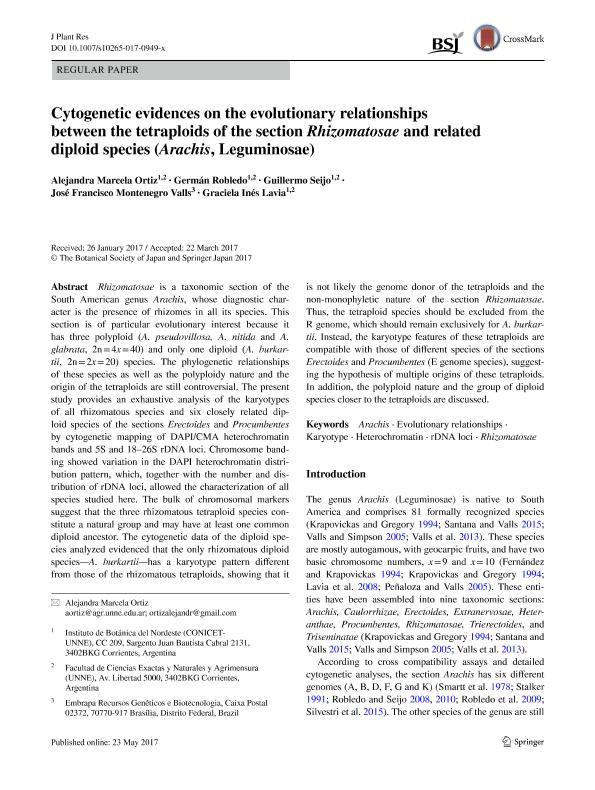Mostrar el registro sencillo del ítem
dc.contributor.author
Ortiz, Alejandra Marcela

dc.contributor.author
Robledo Dobladez, Germán Ariel

dc.contributor.author
Seijo, José Guillermo

dc.contributor.author
Valls, José Francisco Montenegro
dc.contributor.author
Lavia, Graciela Inés

dc.date.available
2017-07-14T20:43:54Z
dc.date.issued
2017-05
dc.identifier.citation
Ortiz, Alejandra Marcela; Robledo Dobladez, Germán Ariel; Seijo, José Guillermo; Valls, José Francisco Montenegro; Lavia, Graciela Inés; Cytogenetic evidences on the evolutionary relationships between the tetraploids of the section Rhizomatosae and related diploid species (Arachis, Leguminosae); Springer Tokyo; Journal of Plant Research; 5-2017; 1-17
dc.identifier.issn
0918-9440
dc.identifier.uri
http://hdl.handle.net/11336/20667
dc.description.abstract
Rhizomatosae is a taxonomic section of the South American genus Arachis, whose diagnostic character is the presence of rhizomes in all its species. This section is of particular evolutionary interest because it has three polyploid (A. pseudovillosa, A. nitida and A. glabrata, 2n = 4x = 40) and only one diploid (A. burkartii, 2n = 2x = 20) species. The phylogenetic relationships of these species as well as the polyploidy nature and the origin of the tetraploids are still controversial. The present study provides an exhaustive analysis of the karyotypes of all rhizomatous species and six closely related diploid species of the sections Erectoides and Procumbentes by cytogenetic mapping of DAPI/CMA heterochromatin bands and 5S and 18–26S rDNA loci. Chromosome banding showed variation in the DAPI heterochromatin distribution pattern, which, together with the number and distribution of rDNA loci, allowed the characterization of all species studied here. The bulk of chromosomal markers suggest that the three rhizomatous tetraploid species constitute a natural group and may have at least one common diploid ancestor. The cytogenetic data of the diploid species analyzed evidenced that the only rhizomatous diploid species—A. burkartii—has a karyotype pattern different from those of the rhizomatous tetraploids, showing that it is not likely the genome donor of the tetraploids and the non-monophyletic nature of the section Rhizomatosae. Thus, the tetraploid species should be excluded from the R genome, which should remain exclusively for A. burkartii. Instead, the karyotype features of these tetraploids are compatible with those of different species of the sections Erectoides and Procumbentes (E genome species), suggesting the hypothesis of multiple origins of these tetraploids. In addition, the polyploid nature and the group of diploid species closer to the tetraploids are discussed.
dc.format
application/pdf
dc.language.iso
eng
dc.publisher
Springer Tokyo

dc.rights
info:eu-repo/semantics/openAccess
dc.rights.uri
https://creativecommons.org/licenses/by-nc-sa/2.5/ar/
dc.subject
Arachis
dc.subject
Evolutionary Relationships
dc.subject
Karyotype
dc.subject
Heterochromatin
dc.subject
Rdna Loci
dc.subject
Rhizomatosae
dc.subject.classification
Genética y Herencia

dc.subject.classification
Ciencias Biológicas

dc.subject.classification
CIENCIAS NATURALES Y EXACTAS

dc.title
Cytogenetic evidences on the evolutionary relationships between the tetraploids of the section Rhizomatosae and related diploid species (Arachis, Leguminosae)
dc.type
info:eu-repo/semantics/article
dc.type
info:ar-repo/semantics/artículo
dc.type
info:eu-repo/semantics/publishedVersion
dc.date.updated
2017-07-13T19:10:02Z
dc.identifier.eissn
1618-0860
dc.journal.pagination
1-17
dc.journal.pais
Japón

dc.journal.ciudad
Tokio
dc.description.fil
Fil: Ortiz, Alejandra Marcela. Consejo Nacional de Investigaciones Científicas y Técnicas. Centro Científico Tecnológico Conicet - Nordeste. Instituto de Botánica del Nordeste. Universidad Nacional del Nordeste. Facultad de Ciencias Agrarias. Instituto de Botánica del Nordeste; Argentina
dc.description.fil
Fil: Robledo Dobladez, Germán Ariel. Consejo Nacional de Investigaciones Científicas y Técnicas. Centro Científico Tecnológico Conicet - Nordeste. Instituto de Botánica del Nordeste. Universidad Nacional del Nordeste. Facultad de Ciencias Agrarias. Instituto de Botánica del Nordeste; Argentina
dc.description.fil
Fil: Seijo, José Guillermo. Consejo Nacional de Investigaciones Científicas y Técnicas. Centro Científico Tecnológico Conicet - Nordeste. Instituto de Botánica del Nordeste. Universidad Nacional del Nordeste. Facultad de Ciencias Agrarias. Instituto de Botánica del Nordeste; Argentina
dc.description.fil
Fil: Valls, José Francisco Montenegro. Embrapa Recursos Genéticos e Biotecnologia; Brasil
dc.description.fil
Fil: Lavia, Graciela Inés. Consejo Nacional de Investigaciones Científicas y Técnicas. Centro Científico Tecnológico Conicet - Nordeste. Instituto de Botánica del Nordeste. Universidad Nacional del Nordeste. Facultad de Ciencias Agrarias. Instituto de Botánica del Nordeste; Argentina
dc.journal.title
Journal of Plant Research

dc.relation.alternativeid
info:eu-repo/semantics/altIdentifier/url/https://link.springer.com/article/10.1007%2Fs10265-017-0949-x
dc.relation.alternativeid
info:eu-repo/semantics/altIdentifier/doi/http://dx.doi.org/10.1007/s10265-017-0949-x
Archivos asociados
